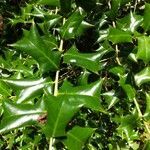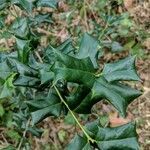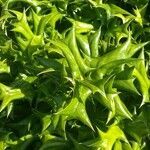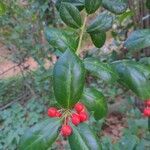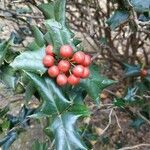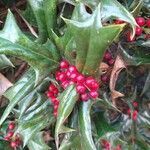Shrubs or small trees, evergreen, (0.6-)1-4 m tall. Young branchlets longitudinally ridged and sulcate, puberulent or glabrescent along groove; older branchlets gray-white, subterete, longitudinally minutely fissured, leaf scars raised, lenticels absent. Petiole 4-8 mm, adaxially narrowly sulcate and puberulent; leaf blade abaxially greenish, adaxially deep green, shiny, quadrangular-oblong, rarely ovate, 4-9 × 2-4 cm, thickly leathery, both surfaces glabrous, midvein impressed adaxially, lateral veins 5 or 6 pairs, anastomosing near margin, evident abaxially, obscure adaxially, base rounded or subtruncate, margin with 1 or 2 spines per side, sometimes entire, apex with 1 strong spine often reflexed. Inflorescences: cymes, fasciculate, axillary on second year’s branchlets; persistent scales suborbicular, pubescent and ciliate; bracts ovate, pubescent, ciliate, apex obtuse or mucronate; flowers yellowish, 4-merous. Male inflorescences: cymes of order 1 or 2, 1-3-flowered; pedicels 5-6 mm, glabrous; bracteoles basal, broadly deltoid; calyx discoid, ca. 2.5 mm in diam., lobes broadly deltoid, ca. 0.7 × 1.5 mm, membranous, sparsely puberulent, ciliate; corolla rotate, ca. 7 mm in diam., petals reflexed, oblong-ovate, 3-4 mm, basally connate; stamens ca. as long as or slightly longer than petals, anthers oblong-ovoid, ca. 1 mm; rudimentary ovary subglobose, apex obtuse or rounded, indistinctly 4-lobed. Female inflorescences: 1-flowered cymes; pedicels 7-9 mm, glabrous; bracteoles 2, basal, broadly triangular; calyx and corolla as in male flowers; staminodes ca. 4/5 as long as petals, sterile anthers ovoid-sagittate; ovary oblong-ovoid, 3-4 mm, ca. 2 mm in diam., stigma discoid, 4-lobed. Fruit red, globose, 8-10 mm in diam.; fruiting pedicel 1.3-1.4 cm; persistent calyx quadrangular; persistent stigma discoid, distinctly 4-lobed; pyrenes 4, obovoid or ellipsoidal, 7-8 mm, ca. 5 mm in diam., rugose and rugose-pitted throughout, abaxially longitudinally 1-sulcate, endocarp bony. Fl. Apr-May, fr. Aug-Dec. 2n = 38*.
More
An evergreen shrub. It grows to 3.5 m high. It spreads 4.5 m wide. The leaves are thick and glossy. They are almost rectangular and spiny. It is self fertile. The fruit are berries. They are larger than English holly. There are several named varieties. The fruit are round and red and 1 cm across.
